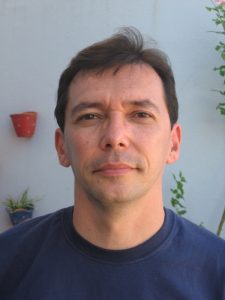 Manuel M. Oliveira is an Associate Professor of Computer Science at the Federal University of Rio Grande do Sul (UFRGS), in Brazil. He received his PhD from the University of North Carolina at Chapel Hill, in 2000. Before joining UFRGS in 2002, he was an Assistant Professor of Computer Science at the State University of New York at Stony Brook (2000 to 2002). In the 2009-2010 academic year, he was a Visiting Associate Professor at the MIT Media Lab. His research interests cover most aspects of computer graphics, but especially the frontiers among graphics, image processing, and vision (both human and machine). In these areas, he has contributed a variety of techniques including relief texture mapping, real-time filtering in high-dimensional spaces, efficient algorithms for Hough transform, new physiologically-based models for color perception and pupil-light reflex, and novel interactive techniques for measuring visual acuity. Dr. Oliveira was program co-chair of the ACM SIGGRAPH Symposium on Interactive 3D Graphics and Games 2010 (I3D 2010), and general co-chair of ACM I3D 2009. He is an Associate Editor of IEEE TVCG and IEEE CG&A, and a member of the CIE Technical Committee TC1-89 “Enhancement of Images for Colour Defective Observers”. He received the ACM Recognition of Service Award in 2009 and in 2010. His talk will take place on Tuesday, January 31st, 1 pm in room E105.
Manuel M. Oliveira is an Associate Professor of Computer Science at the Federal University of Rio Grande do Sul (UFRGS), in Brazil. He received his PhD from the University of North Carolina at Chapel Hill, in 2000. Before joining UFRGS in 2002, he was an Assistant Professor of Computer Science at the State University of New York at Stony Brook (2000 to 2002). In the 2009-2010 academic year, he was a Visiting Associate Professor at the MIT Media Lab. His research interests cover most aspects of computer graphics, but especially the frontiers among graphics, image processing, and vision (both human and machine). In these areas, he has contributed a variety of techniques including relief texture mapping, real-time filtering in high-dimensional spaces, efficient algorithms for Hough transform, new physiologically-based models for color perception and pupil-light reflex, and novel interactive techniques for measuring visual acuity. Dr. Oliveira was program co-chair of the ACM SIGGRAPH Symposium on Interactive 3D Graphics and Games 2010 (I3D 2010), and general co-chair of ACM I3D 2009. He is an Associate Editor of IEEE TVCG and IEEE CG&A, and a member of the CIE Technical Committee TC1-89 “Enhancement of Images for Colour Defective Observers”. He received the ACM Recognition of Service Award in 2009 and in 2010. His talk will take place on Tuesday, January 31st, 1 pm in room E105.
Efficient Deconvolution Techniques for Computational Photography
Abstract: Deconvolution is a fundamental tool for many imaging applications ranging from microscopy to astronomy. In this talk, I will present efficient deconvolution techniques tailored for two important computational photography applications: estimating color and depth from a single photograph, and motion deblurring from camera shake. For the first, I will describe a coded-aperture method based on a family of masks obtained as the convolution of one “hole” with a structural component consisting of an arrangement of Dirac delta functions. We call this arrangement of delta functions the structural component of the mask, and use it to efficiently encode scene distance information. I will then show how one can design well-conditioned masks for which deconvolution can be efficiently performed by inverse filtering. I will demonstrate the effectiveness of this approach by constructing a mask for distance coding and using it to recover color and depth information from single photographs. This lends to significant speedup, extended range, and higher depth resolution compared to previous approaches. For the second application, I will present an efficient technique for high-quality non-blind deconvolution based on the use of sparse adaptive priors. Despite its ill-posed nature, I will show how to model the non-blind deconvolution problem as a linear system, which is solved in the frequency domain. This clean formulation lends to a simple and efficient implementation, which is faster and whose results tend to have higher peak signal-to-noise ratio than previous methods.